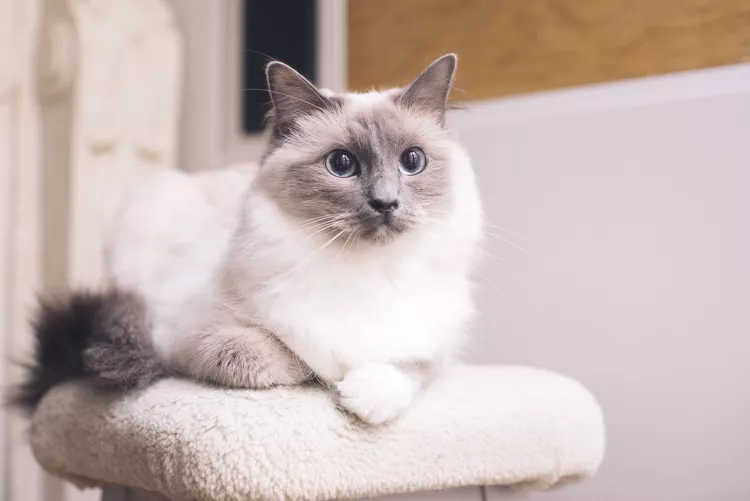Why is My Cat’s Third Eyelid Showing?

A cat's third eyelid is called the nictitating membrane, which, in addition to the upper and lower eyelids, is a third eyelid that you normally don't see. In some cases, a protruding third eyelid is actually a sign of illness or injury.
Learn more about a cat's third eyelid and what it means if you see it.
What Does a Cat’s Third Eyelid Do?
The nictitating membrane is located in the corner of each eye towards the center of the face. The third eyelid is typically retracted and not visible. Certain situations may cause the third eyelid to protrude and partially cover the eyeball.
How to Spot a Cat's Third Eyelid
It is uncommon to see your cat's third eyelids. If your cat's third eyelid is healthy, it should only appear as a crescent, shaped slit at the corner of each eye.
Reasons for a Cat's Third Eyelid to Appear
In many cases, the appearance of the third eyelid indicates there is something wrong.
There are several reasons for a protruding third eyelid in cats. Some are considered normal while others are problematic.
Sleepiness or Relaxed State
It is normal for part of the third eyelids to show when a cat is very relaxed or tired. You may notice that the third eyelids are up while your cat sleeps or right after waking. The third eyelid should retract as soon as the cat is awake and alert. If the third eyelid stays up for longer than
Sedation or Anesthesia
If your cat was given anesthesia or sedation for a medical procedure, the third eyelid will appear and partially cover the eye due to extreme physical relaxation. The effect may last for several hours after waking but should gradually go away. This is considered normal and is not a problem unless the third eyelid remains up after the day of the procedure.
Conjunctivitis
The conjunctiva is a thin, transparent mucous membrane that lines the inside of the eyelids and covers the front part of the eye. Sometimes called "pink eye," conjunctivitis simply means inflammation of the conjunctiva. It may be caused by an infection, allergies, injury, or an eye irritant. It is not uncommon for conjunctivitis to cause inflammation and protrusion of the third eyelid. Cats with conjunctivitis will typically be treated with medicated eye drops or ointment that contain antibiotics and/or steroids.
Corneal Ulcers
The cornea is clear and covers the front of the eye, including the iris and pupil. A corneal ulcer is a wound to the cornea that causes pain and inflammation in the eye and may make the third eyelid appear. Corneal ulcers are usually caused by an injury to the eye, like a scrape, scratch, or puncture wound. Irritating or abrasive substances can also cause corneal ulcers. A corneal ulcer can quickly become very serious and requires veterinary treatment. Cats with corneal ulcers often need one or more types of eye medications and possibly oral medications too.
Uveitis
The uvea is the middle part of the eyeball and contains many blood vessels. Inflammation of the uvea is called uveitis. It often makes the eye appear very red and is sometimes painful. The third eyelid may or may not be affected.
Glaucoma
Glaucoma is a painful eye condition that causes pressure to build up in the eye. This occurs because the aqueous humor (fluid within the front part of the eye) is unable to drain properly. Excess pressure causes damage to the optic nerve and may result in blindness. Third eyelid inflammation may sometimes accompany glaucoma.
Cherry Eye
The third eyelid contains a gland that can become swollen and look like a round protrusion from the inner corner of the eye. This is called prolapse of the nictitating membrane, or cherry eye. It is relatively uncommon in most cats but common in Burmese cats. Surgery is the treatment for cherry eye.
Eye Growths
Growths, tumors, masses, and cysts in and around the eye can lead to inflammation and protrusion of the third eyelid. Contact your vet if you notice an abnormal growth or swelling in or around your cat's eye before it causes more trouble.
Horner’s Syndrome
Horner's syndrome is a neurological disorder that is caused by a dysfunctioning nerve. It affects the eyes and facial muscles, making the eyes appear asymmetrical. The third eyelid is often very prominent in one eye. The eyelids droop and the eye itself appears "sunken in." Horner's syndrome may be caused by trauma or a tumor, but sometimes the cause cannot be determined. The condition may resolve on its own.
When to Seek Medical Attention
If you notice your cat's eyelid protruding, and it doesn't seem to be caused by sleep, relaxation, sedation, or anesthesia, then it probably means there is a problem. Contact your veterinarian as soon as possible to seek advice. If your cat is showing other signs of illness, then it's best to get your cat to the vet for an examination. Do not attempt to put anything in the eye without your vet's recommendation as this can make things much worse. Eye problems can easily go from bad to worse, so do not delay in seeing your vet.